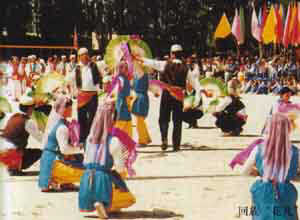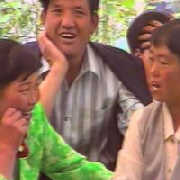
In Hehuang, Hua'er Meetings are held in various folk festivals in different places. Among them the most influential ones include: Xining Hua'er Meeting held on the eighth day of the fourth month of the Chinese lunar calendar; and Minhe County's Xiamen Hua'er Meeting held around theDragon Boat Festival
Other influential ones are Datong County's Laoye Mountain Hua'er Meeting, Minhe's Qili Temple Hua'er Meeting and Huzhu County's Wufeng Temple Hua'er Meeting, which are all held on the sixth day of the sixth month; Ledu County'sQutan TempleHua'er Meeting held from the 14th to the 16th day of the sixth month; and Huzhu County's Danma Hua'er Meeting often held from the 15th to the 17th of the sixth month.
 Contest
Contest
 At the peak of the Hua'er Meeting, pairs of man and woman singers usually perform in the antiphonal style. After they finish each ditty, the audience would toast to them, before continuing to sing. After a few rounds, those who cannot stick to the end will be eliminated, and the best singer will be selected to challenge the best of the neighboring group. The audience of each group will also escort the group's singer and cheer for the singer to join another one.
At the peak of the Hua'er Meeting, pairs of man and woman singers usually perform in the antiphonal style. After they finish each ditty, the audience would toast to them, before continuing to sing. After a few rounds, those who cannot stick to the end will be eliminated, and the best singer will be selected to challenge the best of the neighboring group. The audience of each group will also escort the group's singer and cheer for the singer to join another one.
As the number of the groups decreases, the size grows. At the end, all the singers and audiences will gather into one very huge group, thus beginning the championship contest.
Besides being a competition of voice and aria, the contest also requires high standards concerning the performer's ability in improvising lyrics and answering the audience's questions. The lyrics are supposed to be vivid, precise, and innovative. The first two lines should be cited from literary classics, novels, folk mythologies, legends and historical stories; and the latter two should be in rhyme. Four to five champions will be selected, and after the contest, all the singers will exchange presents and make friends with each other.
Not only does the local singers take part in the Hua'er Meetings; singers from neighboring counties or even neighboring provinces also participate. Silent mountains and fields turn into a jubilant world with Hua'er songs floating everywhere, binding the hearts of the youth together. Under such atmosphere, clever and improvised lyrics and classic dialogues between the lovers frequently abound.
 The sizes of Hua'er Meetings vary greatly from a few hundred participants to tens of thousands. The singers can sing antiphonally in groups or by themselves. Nowadays, the Hua'er Meeting is also a grand market fair. The integration of commercial activity has promoted both the thriving and influence of Hua'er Meeting and the development of the local economy.
The sizes of Hua'er Meetings vary greatly from a few hundred participants to tens of thousands. The singers can sing antiphonally in groups or by themselves. Nowadays, the Hua'er Meeting is also a grand market fair. The integration of commercial activity has promoted both the thriving and influence of Hua'er Meeting and the development of the local economy.
As a proof of friendship and unity among the region's ethnic groups, Hua'er Meetings liven up the public cultural activities, plays an important role in connecting people, and provides a window for the research of the folk customs in West China. With such great influence, Hua'er is also called "the spiritual encyclopedia of the people on the plateau."
 Classifications
Classifications
 There are mainly two sub genres of the art form: Hehuang Hua'er and Taomin Hua'er.
There are mainly two sub genres of the art form: Hehuang Hua'er and Taomin Hua'er.
Hehuang Hua'er, also known as "Shaonian" (youth), mainly prevails in Hezhou of Gansu (currently Gansu's Linxia Hui Autonomous Prefecture) and the region along Qinghai's Huangshui River. This genre is more widespread and more influential with more audio and video releases.
Hehuang Hua'er boasts rich tunes with elegant, simple and vivid lyrics as well as very compact structure, enabling the art form to brilliantly express emotions. Each part contains four or six sentences. The singing is also done in a free style, most of which are solo, with antiphonal singing and group singing. The melody of Hehuang Hua'er is sonorous, bold and unrestrained. There are more than a hundred tunes and more than 40 are very widespread.
